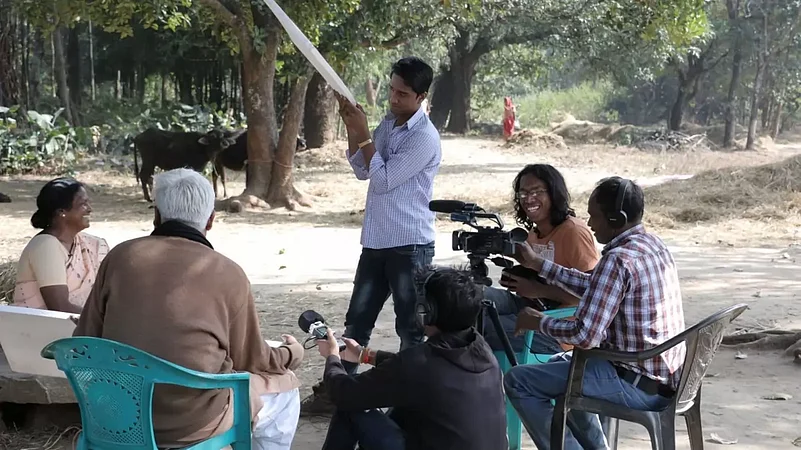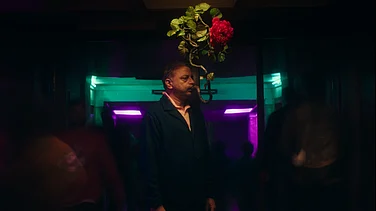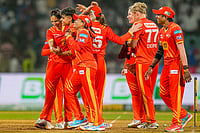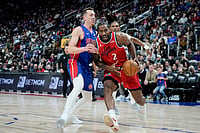It was December 2008. The country was witnessing widespread protests and demonstrations against land grabbing and displacements. On a fine winter morning, film director and cartoonist K P Sasi gave a call to Jharkhand-based filmmaker and activist Meghnath, who, until now, has been supporting people’s struggle against destructive development. KP said they should take a side and highlight the plight of displaced people who were agitating across the country.
Meghnath started penning a song, but the lyrics failed to capture the pain of the protestors. In Meghnath’s words, the ‘flow’ was missing. Senior journalist Vinod Kumar did the needful and weaved the song together with his lyrics. Activist and writer Sunil Minj gave a nationalist flavour to the song with lines like ‘gaon chorenge nahi, gaon chorab nahi’. Music composer and producer Santosh Nair gave his musical touch. The song needed a powerful voice. Arrangements were made so that Jharkhand-based folk artist and Padma Shri Madhu Mansuri Hasmukh could reach a studio in Mumbai and lend his revolutionary voice to the song.
One year later, under the banner of Akhra—a production house—a five-minute documentary film-cum-song ‘gaon chorab nai’ was released. The hard work, collective effort and good intentions paid off and it was a massive hit not just in India but even internationally.
What worked for the song was that it depicted the culture of every state like the Garba of Gujarat, Bihu of Assam and Sarhul of Jharkhand. Today, this song, which has so far been sung in 25 different versions till date, is an obvious choice when there are protests related to jal, jungle, zameen. Students protesting at Jawaharlal Nehru University or the Film and Television Institute of India (FTII), among others, too, have used this song as a medium to raise their voices.
The song will soon be completing 15 years and the banner under which it was made will complete 30 years of its existence. In these 30 years, Akhra has made several documentary movies addressing the issues of water, forest, land, language, culture, displacement and migration of the tribal community.
The Foundation of Akhra
There are two prominent faces of Akhra—Biju Toppo and Meghnath; both recipients of the National Award. While talking about their collaboration and Akhra established itself as a big banner in Jharkhand, Toppo says: “I moved to Ranchi when I was a student. I met Meghnath in 1991 when I was in college. He was of the opinion that tribal students should not just focus on their studies with an aim of seeking a job. Rather, the should have an intellectual understanding of communicating through cinema and photography.”
He wanted the tribal youth to also have a strong association with creative fields like media, film and photography, so that they could take their struggle to every corner of the country. “We started meeting each other quite often. We made a group in 1994 named Akhra, a place that would encourage tribals to come together and share their joys and sorrow and discuss struggles of mutual settlement. Meghnath, Sunil Minj, Philip Kujur, Ajay Tirky and Zavier Kujur were the prominent members. In 1996, Akhra was registered as a trust. Thereafter, we shifted our focus to films,” says Toppo, 54.
He adds that he realised the power of the camera after joining the group and with this strength, the struggle of tribals on the issues of water, forest and land got an edge. He believes that the land movement in Jharkhand in the 90s became the major reason for laying the foundation of Akhra. Toppo, who hails from a remote village in Latehar district, made a mark at the national and international level. He has been teaching camera at the Mass Communication department of the prestigious St. Xavier’s College.
Meghnath, whose career spans 30 years, has never considered himself a filmmaker. He feels he is a social worker. Born in a business family in Mumbai, Meghnath was never interested in that aspect of his family. After completing his studies at St. Xavier’s College Kolkata in 1971, he started doing social work. He moved to Bangalore in 1980 and was inspired by his teacher, activist Stan Swami. In 1981, he started working on the problem of bonded labour in Palamu. He worked actively on various issues till 1988-89. He says that he has observed the displacement, and migration of tribals very closely during this period.
However, for him, films meant songs and dances and he was not aware of the documentary film genre. Meghnath, 70, says: “I was into photography since college. My friends encouraged me to make films. They made me understand that it was a strong medium through which I could tell stories about society. In 1989, I joined a Delhi-based institution to learn filmmaking. Soon, I started collaborating with the likes of Tapan Bose and Suhasini Mule. I learnt that cinema is a movement. I came back to Jharkhand in 1991. Along with social work, for me, the era of films began here.” Meghanth taught cinema to students at St. Xavier’s College, Ranchi for ten years.
Awards and Accolades
Akhra has made several movies on tribal movements—their undocumented deaths, unlawful incarcerations, forests, land, language, culture, migration and, most importantly, displacement issues being faced by them. In a period of 30 years, through nearly 60 documentary films, they made the people aware of the hardships faced by the tribal population, both nationally, and internationally. In a career spanning 30 years, Akhara has received about two dozen national and international awards, including three National Film Awards.
In 2010, the film ‘Loha Garam Hai’ was awarded the Best Environmental Film. The same year, ‘Ek Ropa Dhaan’, received the Best Promotional Film award. ‘Loha Garam Hai’ received two more awards that year. This film tells about the damage caused to the environment by the sponge iron industry in Jamshedpur in Jharkhand and Sundargarh in Odisha and the sufferings of people living in the region. ‘Ek Ropa Dhan’ is based on the SRI process of paddy cultivation. 'Nachi Se Banchi' was awarded with the Rajat Kamal at the 65th National Award in 2017. The film depicts the works of Padma Shri Ram Dayal Munda on the tribal culture and language.

Akhra has made many popular films which highlight an understanding of the incidents of the past and has documented these as evidence. The 1996 film ‘Shaheed Jo Anjaan Rahe’, is the first documentary film made under the Akhra banner. It is based on the massacre of 14 tribals, including former MP and activist Father Antony Murmu, over a pond dispute in Sahibganj district of Jharkhand in 1985.
In 1997-98, the film ‘Chinti Lari Haathi Se’ shows the struggle, displacement and migration of tribals agitating against bauxite mining in Chhattisgarh and Jharkhand. In 2000, the film 'Humare Gaon Mein Hamara Raj' explains the constitutional rights given to the Gram Sabha in the tribal village under the PESA Act of 1996.”
Likewise, 2003 film ‘Vikas Bandook Ki Naal se’ depicts the ground reality of the land encroachment being done as well as the struggles of locals, tribal, aboriginals and how they were being subjugated by the police. This film mostly depicts protests in the states of Odisha, Chhattisgarh, Madhya Pradesh, Jharkhand and Gujarat.
‘Gari Lohardagga Mail’ released in 2006, documents the culture of Jharkhand and the 100-year journey of a train running between Ranchi and Lohardaga. It is interesting to note that in ‘Gadi Lohardagga Mail’, three Padma Shri award recipients from Jharkhand had worked together—Ram Dayal Munda, Nagpuri singer Mukund Nayak, Madhu Mansuri Hasmukh.
The 2015 film, ‘The Hunt’ depicted the deaths of ordinary tribals in the shootout between Maoists and police in the Bastar district of Chhattisgarh and the Saranda area of Chaibasa in Jharkhand. Many such films of Akhra depict the reality of society.
Spreading their wings
When Toppo and Meghnath started teaching camera work at the Mass Communication Department of St. Xavier’s College, many students got associated with Akhra. They were trained as per their talent and interest. Amit Bahudar, 36, has been a part of the students group who started his career with Akhra, and, at present, he is working as an editor at Shah Rukh Khan’s production house, Red Chillies. He says, “I have learnt the ABC of cinema from Akhra. It has helped me understand the base of cinema.” Bahudar is associated with Khan’s recent blockbusters like Pathaan and Jawan.
Seral Murmu, who is presently making a documentary on tribals, says: “I have understood world cinema through Akhra. It helped me understand tribal issues and gain an intellectual understanding of films. Murmu has won the joint award at the Dahaka International Youth Film Festival for his short film, Sondhayni. The film highlights tribal issues.
Rupesh Sahu has been working in association with Akhra for years. Recently, his film Rat Trap, based on the coal workers of Jharkhand, received the Satyajit Ray Silver Award for the second-best documentary. He says that whatever he has achieved today has been due to Akhra. There are many such students for whom Akhra has been a source of inspiration.
(Translated by Kaveri Mishra)



























